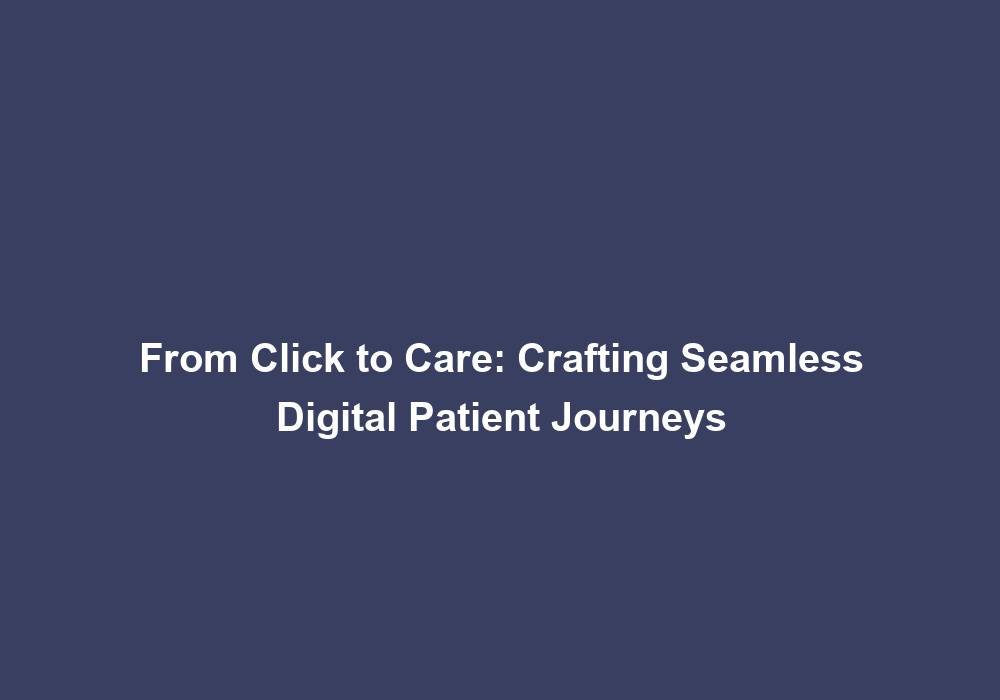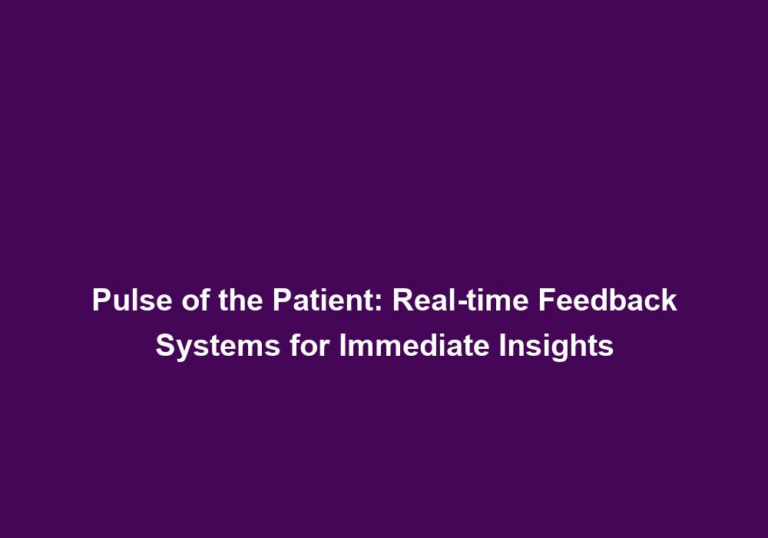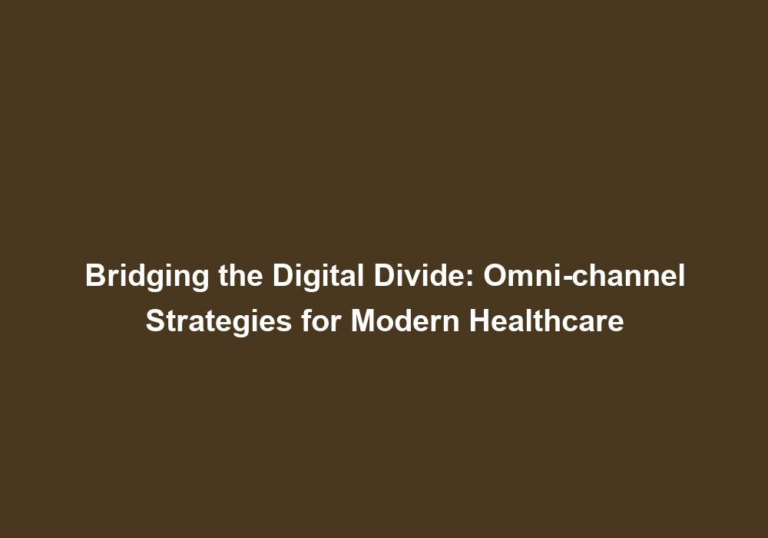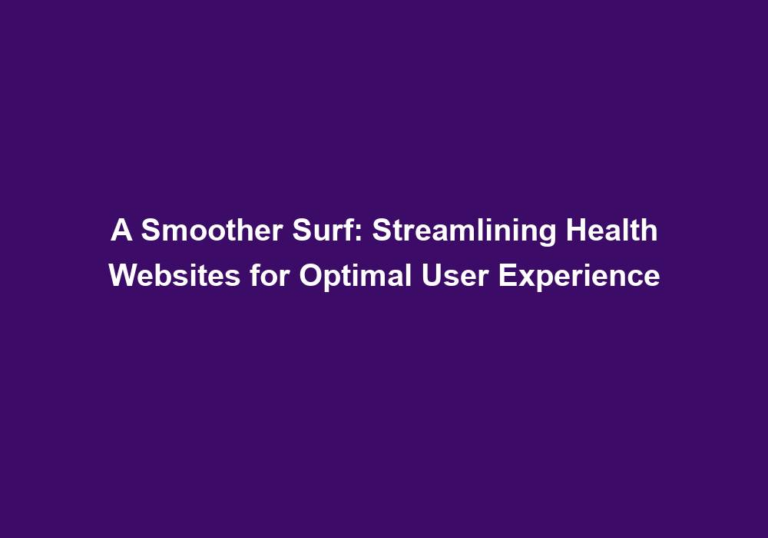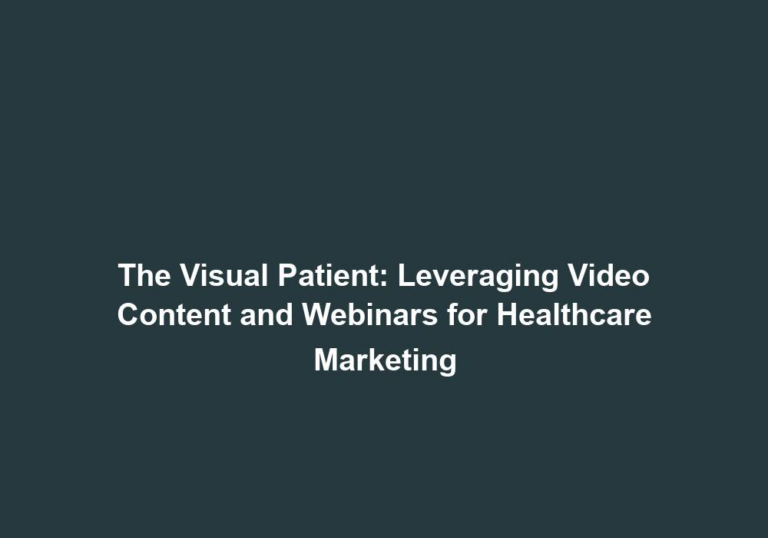From Click to Care: Crafting Seamless Digital Patient Journeys
In today’s digital age, the healthcare industry is undergoing a significant transformation. With the advancement of technology, patients now have access to a wealth of information and resources online. As a result, it is crucial for healthcare providers to create seamless digital patient journeys that ensure a smooth transition from the initial click to receiving quality care. In this article, we will explore the importance of crafting such journeys and provide valuable insights on how to optimize the patient experience.
Understanding the Digital Patient Journey
The digital patient journey refers to the various touchpoints a patient encounters from the moment they begin searching for healthcare information online to the point of receiving medical services. It is imperative for healthcare providers to understand this journey in order to effectively engage with patients and provide them with the necessary support and care.
Stage 1: Awareness and Education
In the initial stage of the digital patient journey, individuals often seek information about symptoms, conditions, and treatment options. To capture the attention of these potential patients, healthcare providers should focus on creating informative and engaging content. This can be achieved through blog posts, articles, videos, and even social media campaigns.
During this stage, it is important for healthcare providers to develop SEO-optimized content to ensure visibility in search engine results. By utilizing relevant keywords and optimizing meta tags, healthcare organizations can increase their chances of appearing on the first page of search results. Additionally, providing accurate and reliable information is crucial in establishing trust and credibility with patients. Healthcare providers should ensure that the content they produce is evidence-based and backed by reputable sources.
To enhance user engagement, visual and interactive elements can be incorporated into the content. Infographics, videos, and interactive tools can help patients better understand complex medical concepts and make informed decisions about their healthcare. By presenting information in a visually appealing and interactive manner, healthcare providers can effectively educate and engage potential patients.
Stage 2: Evaluation and Consideration
Once patients have gathered sufficient information, they enter the evaluation stage, where they compare different healthcare providers, services, and treatment options. During this stage, it is crucial for healthcare organizations to showcase their expertise and highlight the unique aspects of their services.
Creating a user-friendly website is essential in this stage. The website should be easy to navigate and provide comprehensive information about the organization’s services. It should include detailed descriptions of the healthcare providers, their qualifications, and the range of services offered. Additionally, patient testimonials and success stories should be prominently displayed to build trust and confidence in potential patients. These testimonials can highlight the positive experiences of previous patients and demonstrate the organization’s commitment to providing quality care.
Offering virtual tours or interactive tools can also be beneficial during the evaluation stage. By allowing patients to explore the facility and understand the care process, healthcare providers can provide a glimpse into what patients can expect during their visit. This can help alleviate any concerns or anxieties patients may have and increase their confidence in choosing the healthcare provider.
Stage 3: Conversion and Booking
After the evaluation stage, patients are ready to make a decision and book an appointment. This is a critical moment for healthcare providers to simplify the booking process and ensure a seamless experience for the patients.
Implementing an intuitive online booking system is essential at this stage. The system should allow patients to easily schedule appointments by selecting their preferred date and time. It should provide real-time availability and send automated appointment confirmations to patients. Additionally, offering multiple communication channels, such as phone, email, and live chat, can cater to different patient preferences and make it convenient for them to reach out for assistance.
Sending appointment reminders is another important consideration. By sending reminders via email or SMS, healthcare providers can reduce no-shows and enhance patient satisfaction. Reminders can include important details such as the date, time, and location of the appointment, as well as any specific instructions or preparations required.
Stage 4: Care and Follow-up
Once patients have booked their appointments, the focus shifts to providing quality care and maintaining a strong patient-provider relationship. This stage is essential for building patient loyalty and encouraging positive word-of-mouth referrals.
Ensuring timely and efficient service delivery is crucial during the care stage. Minimizing waiting times and providing a comfortable and welcoming environment can significantly improve patient satisfaction. Healthcare providers should strive to deliver care in a compassionate and respectful manner, addressing patients’ concerns and providing personalized attention.
Implementing remote patient monitoring solutions and telehealth platforms can enhance accessibility and convenience for patients. These technologies allow healthcare providers to monitor patients’ health remotely, provide virtual consultations, and offer real-time support. By leveraging these tools, healthcare providers can improve patient outcomes and enhance the overall patient experience.
Regular follow-ups are also important in maintaining a strong patient-provider relationship. Healthcare providers should proactively reach out to patients to monitor their progress, address any concerns or questions, and provide ongoing support. This can be done through phone calls, emails, or secure messaging platforms. By demonstrating continued care and attentiveness, healthcare providers can foster trust and loyalty in their patients.
The Role of Technology in Crafting Seamless Digital Patient Journeys
Technology plays a vital role in creating seamless digital patient journeys. By leveraging innovative tools and solutions, healthcare providers can streamline processes, improve communication, and enhance the overall patient experience.
1. Electronic Health Records (EHRs)
Implementing an advanced EHR system allows healthcare providers to seamlessly access and share patient information across different departments and facilities. This ensures continuity of care and reduces the need for repetitive data entry, enhancing efficiency and patient safety. EHRs also enable healthcare providers to track patient progress, monitor treatment plans, and collaborate with other healthcare professionals involved in the patient’s care.
2. Patient Portals
Patient portals enable individuals to securely access their medical records, schedule appointments, request prescription refills, and communicate with healthcare providers. These portals enhance patient engagement and empower individuals to take an active role in managing their healthcare. By providing patients with convenient and secure access to their health information, healthcare providers can improve communication and facilitate shared decision-making.
3. Telemedicine and Remote Monitoring
Telemedicine and remote monitoring solutions have gained significant popularity, especially in recent times. These technologies enable healthcare providers to offer virtual consultations, remote monitoring of vital signs, and real-time communication with patients. This not only improves access to care but also reduces healthcare costs and enhances patient convenience. Patients can receive timely medical advice, follow-up care, and monitoring from the comfort of their own homes, eliminating the need for unnecessary travel and wait times.
4. Chatbots and Virtual Assistants
Integrating chatbots and virtual assistants on websites and patient portals can provide patients with instant responses to their queries, appointment scheduling assistance, and basic healthcare information. These AI-powered tools enhance the overall patient experience by offering personalized and round-the-clock support. Chatbots can quickly provide answers to frequently asked questions, while virtual assistants can guide patients through the healthcare journey, offering tailored recommendations and resources.
Conclusion
Crafting seamless digital patient journeys is essential for healthcare providers aiming to provide exceptional patient experiences in today’s digital era. By understanding the different stages of the digital patient journey and leveraging technology solutions, healthcare organizations can optimize the patient experience from the initial click to receiving quality care. Embracing innovative tools and strategies will not only attract and retain patients but also boost overall patient satisfaction and loyalty.

